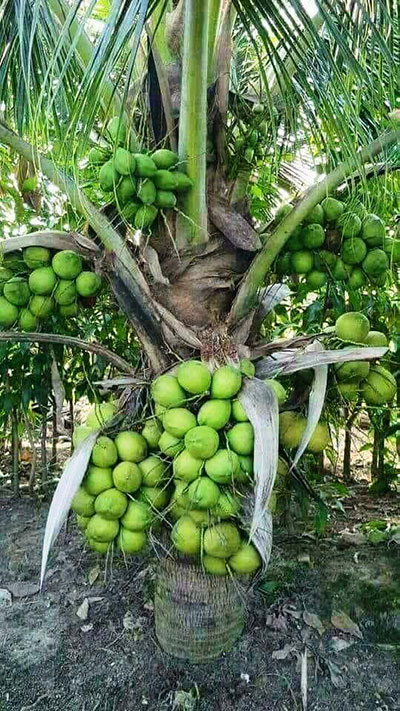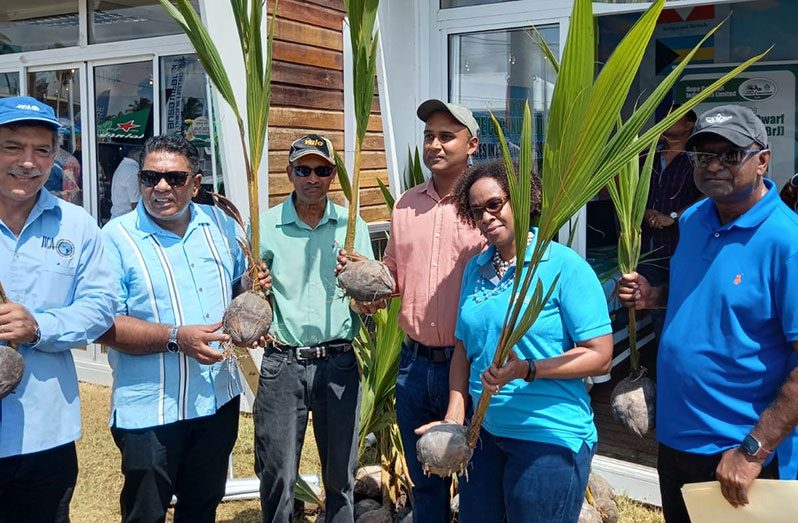DESPITE the fact that Guyana’s coconut industry is flourishing, the current output is not enough to satisfy consumer demand. The Guyana Government declared at the Agri-investment earlier this year that it intends to introduce new, superior coconut types to extend the genetic base of coconuts and increase production.
In order to support the Caribbean Agricultural Research and Development Institute (CARDI) as part of the Regional Coconut Project funded by the EU/CARIFORUM, local officials organised and took part in a tour to the Brazil-based Coconut Seed Nut Farm of Tecnologia Na Produção De Coqueiros (Technology in Coconut Production) (COHIBRA).

The main objectives were to determine whether importing 1,000 Brazilian Green Dwarf seed nuts into Guyana was feasible and to examine COHIBRA’s production procedure to make sure it adhered to Guyana’s plant quarantine regulations. The coconut project’s strategic goal is to increase the availability of high-quality planting material in the area.
Speaking with the Guyana Chronicle, Ricky Roopchand, General Manager of Hope Coconut Industries Limited, explained that a coconut variety usually takes a period of five to 15 years to develop. The Green Dwarf coconut that will be imported from Brazil is a high-yielding three-year variety that took 15 years to develop. According to Roopchand, “it wouldn’t make sense to spend that amount of time, so we will have to pay the price for the neglect and import new varieties.” The Brazilian variety is the first step.
Due to the high cost of the seed nuts, Roopchand related that only 2,000 have been paid for thus far through the government-to-government arrangements between Guyana and Brazil. The Caribbean Agricultural Research and Development Institute (CARDI) has already paid to import the first 1,000 and approval was given, through the Ministry of Agriculture, to the Agriculture Sector Development Unit (ASDU) programme, which is funded by the Inter-American Development Bank (IDB), to import the other set.

GREAT OPTIMISM
The testing and observations of the 2,000 nuts will be done at NAREI and Hope Coconut Industries Limited, after which special plots will be established throughout Guyana, Roopchand explained. He added that there are over 2,000 coconut farmers in Guyana presently and they have shown an interest in the new variety with great optimism. With the high demand for this variety of coconut, Roopchand is hopeful that the funds will become available so that they can import a container that will accommodate at least 14,000 seed nuts, which will give all farmers access to the variety. He also noted that they have had a sensitisation programme in many regions so that farmers are aware of their plans going forward. This is only the beginning of this initiative, and it will be continued over the years, said Roopchand.
The company that is providing the seeds is COHIBRA, which is a research facility located in Fortaleza, Brazil. They are specialised in the production of genetically superior coconut cultivars and coconut pollen—the latter primarily used in their hybridisation programme. To date, COHIBRA has supplied two million seeds and coconut seedlings for both hybrids and dwarves to the local and international markets.
It was also noted that the three-year-old Brazilian Green Dwarf coconut is a superior variety, that is, it has a water volume of approximately 750 milliliters (ml). It is also ideal for oil and copra, compared to Guyana’s traditional variety (Malaysian Dwarf), which has a water content of 350-500 ml and to a lesser extent can be used for copra and oil, but it is not as suitable for that purpose.
In addition to Brazil, the government of Guyana is looking at other countries that have suitable varieties that can grow in Guyana. Some such countries are Mexico and Asia.
FIRM IN DIRECTIVES
Roopchand said the Minister of Agriculture, Zulfikar Mustapha, is very “firm” in his directives with regards to having “a very vibrant breeding programme” which will be established shortly. According to him, a “coconut unit” has already been established at the National Agriculture Research and Extension Institute (NAREI), which is the prime research institution in Guyana.
Roopchand said Guyana is “a little behind when it comes to value-added products with coconuts, and farmers and producers are shortchanged as a result.” He also noted that the government has invested in a coconut fibre machine that would be used to convert the husk into coconut fibre and coconut peat, which is a “wonderful” material for mulching and may be utilised in nurseries due to its high capacity to absorb moisture. Pomeroon is one such area where the machine will greatly assist the people and the environment after it was revealed that coconut husks were being thrown into the river, posing a serious threat to boat users as well.
There has been a significant increase in the capacity for coconut seedlings. At the end of 2022, Guyana should have its 10th nursery in Lethem, bringing the country’s capacity to produce coconut seedlings to a total of two hundred and six thousand per year compared to the year 2020, where the capacity could have only produced fifteen hundred. The decentralised programme enables people from Mabaruma, for example, to have easy access to an adequate number of seedlings at an affordable cost without the hassle of transportation.
In terms of coconut acreage, a conservative target was set to accommodate the expansion of the coconut industry for the next five years. Roopchand explained that the idea was to expand 1,000 acres per year, but in 2021, instead of 1,000 acres, the industry expanded by over 2,000 acres. The same 1,000-acre target was set for this year, but as of August, it has reached 2,759 acres. “It is a good sign for the industry’s trajectory,” Roopchand said.
According to Roopchand, with oil and gas being on the front burners of Guyana’s economy, the President of Guyana, Dr. Irfaan Ali, along with the Minister of Agriculture, has made it clear that the agriculture sector would not be neglected in Guyana’s future. He praised the Government of Guyana and Minister Mustapha for the “phenomenal” job that they have been doing in the sector.
Roopchand also made special mention that, for the past three years, under the capital programme, Hope Estate has received $82 million from the government to fix its infrastructure on the estate as well as under the decentralisation programme where they serve the needs of the farmers.













